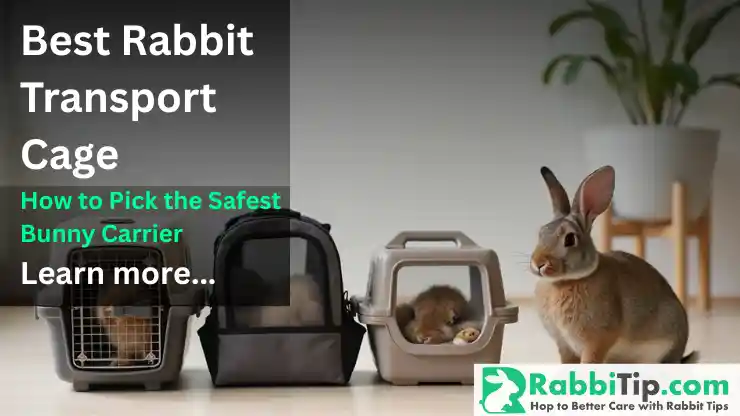Why a Proper Rabbit Transport Cage Matters
Taking your bunny on a trip? You need the right rabbit transport cage! Rabbits get scared easily. Their hearts beat fast when they feel unsafe. A good carrier keeps them calm and protected.
Rabbits have delicate bodies. Their bones break easily if they jump or fall during travel. A proper rabbit transport cage stops these injuries from happening.
What is the best rabbit transport cage?
The best rabbit transport cage depends on your needs:
- Long trips, car rides, or nervous rabbits: Use a Hard-Shell Carrier.
- Short vet visits or calm rabbits: A Soft-Sided Carrier works best.
- Outdoor time in parks or fields: Try a Pet Stroller.
- Emergency or occasional short trips: A DIY Carrier is good enough.
The best rabbit transport cage has:
- Solid, non-slip floor
- Good ventilation on multiple sides
- Secure latches that rabbits can’t open
- Room to turn around and lie down
- Easy access for getting the rabbit in and out
Your furry friend also heats up quickly. In a bad carrier, they might get too hot. This can make them very sick or even lead to heat stroke.
“The right transport cage is not just a box—it’s a safe space that protects your bunny’s physical and mental health during stressful journeys.”
Key Takeaways:
- A good transport cage reduces stress, injury, and overheating
- Different rabbits and situations need different cage types
- DIY cages can work but must meet safety standards
- You should never use housing cages (like breeding cages) for travel without changes
Types of Rabbit Cages: From Housing to Transport
Not all rabbit cages work for travel! Let’s look at the main types and see which ones keep your bunny safe on trips.
Wire Rabbit Cages / Metal Cages
Wire cages make great homes for rabbits. They offer lots of air flow and let your bunny see what’s going on. These metal cages protect rabbits from predators. But they have big problems for travel:
- Too open and drafty for trips
- No protection from bumps or crashes
- Rabbits can hurt their feet on wire floors
- Easy for scared bunnits to get stuck in the bars
Best use: Daily living at home, not for travel unless you add solid sides and a secure top.
Stacked Rabbit Cages
These tall, multi-level homes work well for rabbit owners with many bunnies or small spaces.
- Too big and heavy to move easily
- Doors might open during travel
- Levels can collapse if bumped
- Rabbits might fall between floors during movement
Best use: Home housing for multiple rabbits, never for transport.
Rabbit Breeding Cages
Breeding cages have special nest boxes and extra space. They’re built for mama rabbits and babies, not for trips to the vet!
- Usually very large and bulky
- Made with baby rabbits in mind, not travel safety
- Often have nest box areas that waste space during travel
- Typically have wire floors that hurt feet during bumpy rides
Best use: For rabbit breeding only. Not for any kind of travel.
Commercial Rabbit Cages
These sturdy metal or plastic cages house rabbits on farms or in pet stores. They focus on durability, not mobility.
- Very heavy and hard to carry
- No handles for safe lifting
- Often have slide-out trays that might open during travel
- Limited ventilation when doors are closed
Best use: Permanent housing in shops or farms. Too heavy and unsafe for trips.
Hanging Rabbit Cages
Some rabbit keepers hang cages to save floor space and keep rabbits off the ground. These cages:
- Have no solid bottom for travel
- Swing and move too much
- Offer no protection from bumps
- Can’t sit safely in a car
Best use: Outdoor housing only. Never for transport.
Soft Rabbit Travel Carriers
Now we’re talking about actual travel gear! Soft carriers look like gym bags with mesh windows.
- Lightweight and easy to carry
- Cozy and den-like for nervous rabbits
- Mesh panels for good air flow
- Padded to absorb small bumps
Best use: Short trips to the vet, indoor rabbits, calm bunnies who don’t chew.
Hard-Shell Rabbit Carriers
These plastic carriers with metal doors provide the most protection during travel.
- Strong walls protect from impacts
- Secure latches prevent escapes
- Easy to clean if accidents happen
- More space for longer trips
Best use: Car travel, nervous rabbits, longer journeys, rabbits who chew.
Types of Rabbit Transport Cage
When choosing a rabbit transport cage, you’ll find several options. Each type works best for different situations and rabbits.
Hard-Shell Carriers
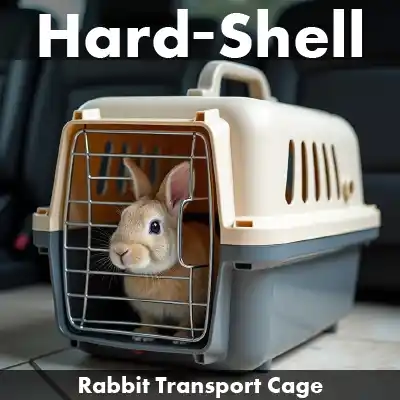
Hard-shell carriers offer the most protection during travel. Made of durable plastic with metal doors, they keep rabbits safe from bumps and falls. They come in various sizes and often feature:
- Sturdy handles for easy carrying
- Multiple ventilation holes
- Secure door latches that prevent escapes
- Easy-to-clean surfaces
These are best for car travel and nervous rabbits who might try to chew their way out.
Soft-Sided Carriers
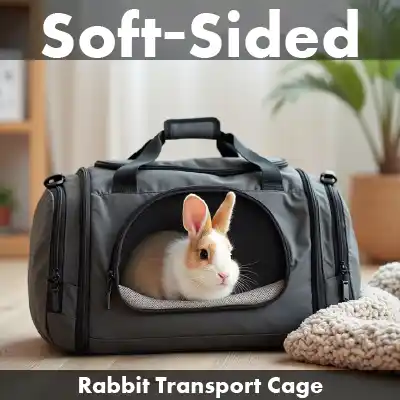
Soft carriers look like duffel bags with mesh panels. They’re lightweight and often have:
- Shoulder straps for easy carrying
- Multiple entry points
- Foldable design for storage
- Soft, padded floors
These work well for calm rabbits on short trips like vet visits. However, they aren’t chew-proof!
Pet Strollers
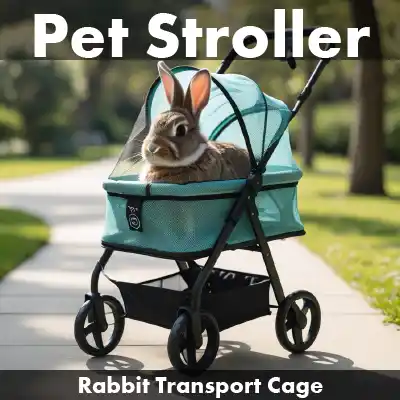
Some rabbit owners use pet strollers for outdoor walks or trips. These have:
- Mesh windows for airflow
- Storage space underneath
- Smooth wheels for gentle movement
Strollers aren’t suitable for car travel but work well for supervised outdoor time.
DIY Transport Carriers
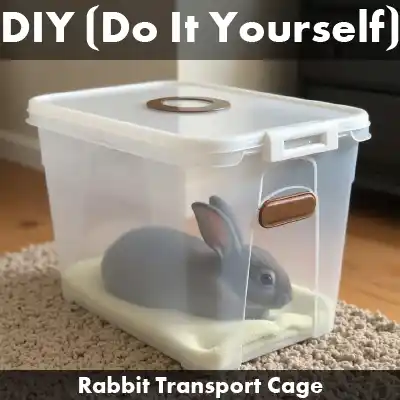
Homemade carriers can work for occasional, short trips. Usually made from plastic storage bins with added ventilation holes and secure lids, they’re:
- Budget-friendly
- Customizable to your rabbit’s size
- Good for emergencies
Always make sure DIY carriers have proper ventilation and cannot be chewed through.
Remember: No matter which type you choose, the carrier should be well-ventilated, escape-proof, and the right size for your rabbit to turn around and lie down comfortably.
Types of Rabbit Transport Cage Comparison
Use this handy comparison table to find the best rabbit transport cage for your needs:
| Feature | Hard-Shell Carriers | Soft-Sided Carriers | Pet Strollers | DIY Carriers |
|---|---|---|---|---|
| Best For | Longer trips, car travel, nervous rabbits | Short vet visits, calm rabbits | Supervised outdoor time | Occasional short trips, emergency use |
| Protection Level | ★★★★★ | ★★★☆☆ | ★★★☆☆ | ★★☆☆☆ |
| Escape-Proof | ★★★★★ | ★★★☆☆ | ★★★☆☆ | ★★★☆☆ |
| Ventilation | ★★★★☆ | ★★★★★ | ★★★★☆ | ★★★☆☆ |
| Comfort | ★★★☆☆ | ★★★★★ | ★★★★★ | ★★☆☆☆ |
| Durability | ★★★★★ | ★★★☆☆ | ★★★☆☆ | ★★☆☆☆ |
| Ease of Cleaning | ★★★★★ | ★★★☆☆ | ★★☆☆☆ | ★★★★☆ |
| Weight | Heavy | Light | Medium | Medium |
| Cost | $25-60 | $20-45 | $40-100 | $10-20 |
| Pros | Highly secure, chew-proof, stable in cars, long-lasting | Lightweight, comfortable, compact for storage | Great visibility, comfortable, good for multiple stops | Budget-friendly, customizable size |
| Cons | Heavier to carry, bulkier to store, harder for rabbits to see out | Not chew-proof, less protection in accidents | Not suitable for car travel, bulky to store | Less secure, may lack proper ventilation, not long-lasting |
| Ideal Trip Length | Long (up to 4 hours) | Short (under 1 hour) | Short outings (under 1 hour) | Very short (under 30 minutes) |
How to Choose:
- Choose Hard-Shell if safety and security are your top priorities or for longer journeys
- Choose Soft-Sided if you need something lightweight and your rabbit is calm
- Choose a Stroller if you want to take your rabbit on gentle outdoor walks
- Choose DIY if you’re on a tight budget and only need occasional transport
Remember: Whatever type you choose, make sure it’s the right size for your rabbit and has proper ventilation!
Soft vs Hard Rabbit Carriers: Which One is Best?
Both soft and hard carriers work for rabbit transport. But each type shines in different situations.
Soft Carrier Benefits:
- Weight: Much lighter to carry, great for kids or people with less strength
- Storage: Folds flat when not in use
- Comfort: Feels cozy and cave-like for shy rabbits
- Look: Often comes in fun colors and styles
- Price: Usually costs less than hard carriers
Hard Carrier Benefits:
- Protection: Better shields your bunny in accidents
- Chew-proof: Stops rabbits from eating their way out
- Cleaning: Wipes down easily after accidents
- Durability: Lasts for many years
- Stability: Sits firmly in cars without tipping
- Access: Top-opening models let you lift rabbits safely
Best Choice For Different Rabbits:
Choose soft carriers for:
- Small, calm rabbits
- Short vet visits
- Rabbits who don’t chew
- When you need to carry the cage far
Choose hard carriers for:
- Larger rabbits
- Anxious or chewy bunnies
- Longer car trips
- Highest safety in vehicles
How to Choose a Safe Rabbit Transport Cage
When picking the best rabbit travel carrier check these key features:
Size Matters
Your rabbit needs enough room to:
- Turn around fully
- Lie down stretched out
- Sit up without hitting their ears on the top
Too small means stress and discomfort. Too big means the rabbit slides around during stops and turns.
Tip: Measure your rabbit from nose to tail while stretched out, then add 2-3 inches. This should be the minimum carrier length.
Escape-Proof Locks
Rabbits get scared during travel. When scared, they try to escape! Look for:
- Double-locking doors that rabbits can’t nudge open
- No gaps larger than 1 inch anywhere
- Secure seams where top and bottom connect
- Strong zippers (for soft carriers) with safety clips
One rabbit owner shares: “My bunny Hoppy figured out how to unzip her first carrier! Now I only use carriers with locking zippers or clips.”
Safe Flooring
Wire floors hurt rabbit feet. During bumpy car rides, this gets even worse. Good carriers have:
- Solid, non-slip floor
- Space for a soft towel or mat
- No holes big enough for paws to get stuck
- Easy-to-clean surface for accidents
Ventilation Checks
Rabbits overheat easily. Your carrier needs many air holes or mesh panels. But not too many—drafts can make rabbits sick.
The best carriers have:
- Ventilation on at least three sides
- Holes too small for a bunny nose to get stuck
- Airflow that doesn’t blow directly on the rabbit
Safe Rabbit Carrier Checklist
✓ Right size for your specific rabbit
✓ Secure, escape-proof closures
✓ Solid, comfortable floor
✓ Good air flow without drafts
✓ Sturdy handle or shoulder strap
✓ Easy to clean materials
✓ Space for a small hay supply
Bunny Cage for Car Travel: Safety Tips
Once you have a good rabbit transport cage, you need to use it safely in the car!
Secure the Carrier
A sliding carrier can hurt your bunny during stops. Always:
- Place the carrier on the floor behind a front seat (safest spot)
- Secure with a seatbelt if on a seat
- Never put the carrier in the trunk—too hot and bumpy!
- Use towels to stop sliding or tipping
Temperature Control
Rabbits can die from heat very quickly. Keep them cool by:
- Never leaving the carrier in a parked car
- Using your car’s AC in summer
- Avoiding direct sunlight through windows
- Bringing a battery-powered fan for hot days
- Draping a light towel over part of the carrier to create shade
Quiet Zone
Loud noises scare rabbits. Their ears are very sensitive. Help them stay calm by:
- Keeping the radio volume low
- Speaking quietly near the carrier
- Avoiding honking or yelling
- Placing the carrier away from noisy doors or windows
Pro tip: Put something that smells like home in the carrier, like a clean towel from their cage. This helps rabbits feel safer.
DIY Rabbit Transport Cage: Is It Worth It?
Store-bought carriers cost $20-$80. Is making your own rabbit transport cage worth it? Let’s see!
DIY Carrier Pros:
- Save money: Use materials you already have
- Custom size: Build exactly right for your rabbit
- Personalized: Add features your bunny needs
- Learning experience: Great project for young rabbit owners
DIY Carrier Cons:
- Safety risks: Homemade carriers might break or open
- Time: Takes hours to build properly
- Tools needed: Requires drilling, cutting, and assembly skills
- May cost more: Buying all supplies can add up to build DIY Rabbit Carrier
When DIY Makes Sense:
Making your own rabbit transport cage works best when:
- You only need it for short, occasional trips
- You have good building skills
- You follow safety guidelines strictly
- Your rabbit is calm and doesn’t chew much
If you travel often with your bunny or go on long trips, a store-bought carrier offers better safety.
How to Build a Rabbit Transport Cage at Home (Step-by-Step)
Ready to make a DIY rabbit transport cage? Follow these steps carefully!
Materials You’ll Need:
- Large plastic storage bin with lid (clear sides help rabbits see out)
- Wire mesh (hardware cloth with small holes)
- Drill with 1/4 inch bit
- Wire cutters
- Zip ties or small nuts and bolts
- Soft towel or fleece for lining
- Sandpaper (to smooth rough edges)

Step 1: Prepare the Bin
- Choose a bin at least 18″ long × 12″ wide × 12″ high for a medium rabbit
- Wash the bin with mild soap and rinse well
- Let it dry completely
- Remove any stickers or rough spots with sandpaper
Step 2: Create Ventilation
Rabbits need lots of fresh air during travel.
- Mark spots for air holes on the top and sides
- Keep holes at least 2″ apart
- Drill holes in the marked spots
- Smooth any rough edges with sandpaper
Important safety tip: Never make holes too big! Your rabbit could get their nose or paws stuck.
Step 3: Make a Viewing Window
Rabbits feel safer when they can see out.
- Draw a rectangle (about 8″ × 6″) on one side
- Cut out the plastic using a sharp utility knife
- Cut wire mesh slightly larger than the opening
- Attach mesh with zip ties or nuts and bolts
- Make sure all edges are smooth and secure
Step 4: Secure the Lid
The most important safety feature is a lid that won’t pop open.
- Test the original latches—are they strong?
- Add extra security with bungee cords or clips
- Make sure the lid can’t shift or pop off if bumped
Step 5: Add Comfort Features
Make the carrier cozy and safe inside.
- Line the bottom with a non-slip mat or towel
- Attach a small hay holder to one side
- Add a small water bottle only for trips longer than 2 hours
Pro tip: Use pet-safe zip ties to attach everything inside. Avoid metal parts that could hurt your bunny.
Best Rabbit Transport Cages You Can Buy (Top 5 Picks)
Don’t want to build your own? These top rabbit transport cages earn great reviews from rabbit owners.
Hard-Shell Carriers:
1. Petmate Two-Door Top-Load Kennel
- Best feature: Top and front loading doors
- Size options: Good for rabbits up to 15 pounds
- Pros: Easy cleaning, secure latches, good ventilation
- Cons: Plastic handle (not as comfortable for long carries)
- Best for: Vet visits and car travel
2. Living World Pet Carrier
- Best feature: Extra wide door for easy access
- Size options: Medium works for most rabbits
- Pros: Sturdy build, good airflow, secure latches
- Cons: Only opens from the front
- Best for: Nervous rabbits who need extra space
3. Amazon Basics Pet Carrier
- Best feature: Budget-friendly price
- Size options: Multiple sizes for different rabbits
- Pros: Durable plastic, good ventilation, secure closure
- Cons: Some sharp edges need filing down
- Best for: Occasional use and short trips
Soft-Sided Carriers:
4. Petsfit Comfort Carrier
- Best feature: Soft fleece floor pad included
- Size options: Small and medium fit most rabbits
- Pros: Washable, folds flat, multiple openings
- Cons: Determined chewers might damage mesh
- Best for: Calm rabbits, short trips, easy carrying
5. Sherpa Original Deluxe Carrier
- Best feature: Approved by many airlines
- Size options: Medium works for rabbits up to 10 pounds
- Pros: Mesh ventilation, shoulder strap, washable liner
- Cons: Higher price than other soft carriers
- Best for: Travel with well-behaved rabbits
How to Choose the Best Rabbit Transport Cage
Want to buy a great rabbit transport cage of you needs? Here’s an easy way to do it:
- Go to your favorite online shopping site.
- Search for the rabbit transport cage types we listed.
- Look at the top-rated cages that show up first.
- Read recent reviews from other buyers.
- Pick the cage with the best ratings and lots of positive feedback.
This helps you find a safe, comfy cage your rabbit will love!
How to Transport a Rabbit Safely: Pro Tips
Having the right rabbit transport cage helps. But how you use it matters just as much!
Before Travel Day
Start training your rabbit to like their carrier:
- Leave the carrier open in your rabbit’s play area
- Put treats and favorite toys inside
- Feed meals near or in the carrier
- Practice short “trips” around the house
- Reward calm behavior with gentle pets and treats
“My rabbit used to panic in carriers,” says rabbit owner Maria. “After two weeks of practice with treats, she hops right in!”
Packing for Rabbit Travel
Never put water bowls in a moving carrier—they spill! Instead:
- Pack fresh, wet veggies like cucumber or lettuce for hydration
- Bring their regular pellets in a sealed bag
- Include plenty of hay (helps keep their digestive system moving)
- Pack extra bedding for accidents
- Bring a small first-aid kit just in case
During Travel
Keep your rabbit calm and safe by:
- Driving smoothly—no fast stops or sharp turns
- Keeping the car quiet—loud music stresses rabbits
- Speaking to your rabbit in a soft, calm voice
- Covering part of the carrier if they seem scared
- Checking on them during breaks (but don’t open the carrier!)
Travel Don’ts
These common mistakes can hurt your bunny:
- Don’t put rabbits and other pets in the same carrier or car area
- Don’t leave your rabbit alone in a parked car (even for “just a minute”)
- Don’t place the carrier where direct sun will hit it
- Don’t feed a full meal right before travel (can cause upset stomach)
- Don’t travel during the hottest part of the day in summer
Conclusion
Picking the right rabbit transport cage keeps your bunny safe and calm during travel. Whether you choose a hard carrier, soft bag, or DIY solution, always put safety first.
Remember these key points:
- Match the carrier to your rabbit’s size and temperament
- Practice at home before real trips
- Never use housing cages for transport without proper changes
- Keep trips short when possible
- Make the carrier a positive space with familiar smells
Traveling with rabbits takes extra care, but seeing your bunny stay calm and healthy makes it worth the effort. With the right carrier and proper preparation, your rabbit can join your adventures safely!
Next Steps for Rabbit Owners:
- Check your current carrier against our safety checklist
- Start carrier training this week with treats and short practice sessions
- Pack an emergency travel kit for your rabbit
- Schedule a short “practice trip” before any big journeys
Safe travels with your bunny friend!
Frequently Asked Questions (FAQs)
How to transport a rabbit in a car?
Place your rabbit in a secure carrier with good airflow. Put the carrier on the floor behind the passenger seat—this spot has the least movement. Never put rabbits in the trunk! Keep the car cool and quiet. For trips over two hours, take breaks but don’t remove the rabbit from the carrier.
What is the best carrier cage for a rabbit?
The best rabbit transport cage has:
- Solid, non-slip floor
- Good ventilation on multiple sides
- Secure latches that rabbits can’t open
- Room to turn around and lie down
- Easy access for getting the rabbit in and out
Hard carriers work best for most trips, but soft carriers work for calm rabbits on short trips.
Can I put my bunny in a carrier?
Yes! Carriers keep rabbits safe during car trips and vet visits. Use a carrier made for small pets rabbits, not a makeshift box or bag. Start with short practice sessions at home so your rabbit gets used to the carrier before a real trip.
How long can a rabbit stay in a cage?
For travel, rabbits should stay in a carrier for less than 4 hours at a time. For longer trips, take breaks every 2-3 hours. Let the carrier sit in a quiet place during breaks, but don’t let the rabbit out unless you’re in a safe, enclosed space.
Can you leave a rabbit alone for 3 days?
No! Rabbits need daily food, water, and care. They can develop serious health problems in just 24 hours. If you travel, have a rabbit-savvy person check on your bunny at least twice daily. This question doesn’t relate to transport cages but shows why traveling with rabbits requires planning.
Is keeping a rabbit in a cage abuse?
Transport cages are for short-term travel only, not living spaces. A rabbit should only stay in a transport cage during trips. At home, rabbits need much larger living spaces with room to hop, stretch, and play. The minimum home cage size should be 4 times larger than a travel carrier.
Can I use a cat carrier as a rabbit transport cage?
Yes! Cat carriers often work great for rabbits. They have good ventilation, secure closures, and solid floors. Make sure it’s the right size—your rabbit needs room to turn around and lie down, but not so much space that they slide during travel.
Should I build or buy a rabbit transport cage?
If you travel rarely and have good DIY skills, building a carrier works for short trips. For frequent travel or longer journeys, buy a commercial carrier. Store-bought carriers undergo safety testing and last for years. The safety of your rabbit matters most!
What’s the best cage for taking my rabbit to the vet?
A hard carrier with top access works best for vet visits. Veterinarians prefer carriers where they can reach in from above to lift your rabbit safely. This causes less stress than pulling them through a front door. Look for carriers with removable tops for the easiest vet exams.

